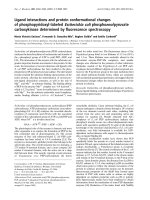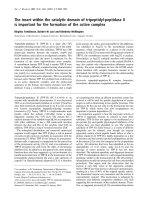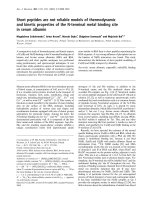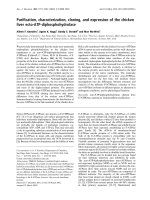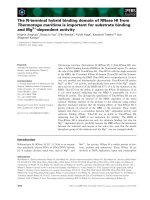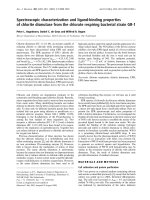Báo cáo y học: " 5'''' long terminal repeat (LTR)-selective methylation of latently infected HIV-1 provirus that is demethylated by reactivation signals" doc
Bạn đang xem bản rút gọn của tài liệu. Xem và tải ngay bản đầy đủ của tài liệu tại đây (456.77 KB, 7 trang )
BioMed Central
Page 1 of 7
(page number not for citation purposes)
Retrovirology
Open Access
Short report
5' long terminal repeat (LTR)-selective methylation of latently
infected HIV-1 provirus that is demethylated by reactivation signals
Takaomi Ishida, Akiko Hamano, Tsukasa Koiwa and Toshiki Watanabe*
Address: Laboratory of Tumor Cell Biology, Department of Medical Genome Sciences, Graduate School of Frontier Sciences, The University of
Tokyo, 4-6-1 Shirokanedai, Minato-ku, Tokyo 108–8639, Japan
Email: Takaomi Ishida - ; Akiko Hamano - ; Tsukasa Koiwa - ;
Toshiki Watanabe* -
* Corresponding author
Abstract
We previously described selective hypermethylation of the 5'-long terminal repeat (LTR) of HTLV-
1 provirus in vivo and in vitro. This prompted us to analyze CpG methylation of the two LTRs of the
HIV provirus in chronically infected cell lines. The results demonstrate selective hypermethylation
of the 5' LTR of the HIV provirus in ACH-2 cells. Moreover, induction of viral gene expression by
TNF-α resulted in demethylation of the 5'-LTR. These results suggest that selective epigenetic
modification of the 5'LTR of the HIV-1 provirus may be an important mechanism by which proviral
activity is suppressed.
Findings
With the use of highly active anti-retroviral therapy
(HAART) for HIV-infected individuals, greater control of
viral replication is now possible. The widespread use of
HAART has led to a substantial decline in the incidence of
acquired immunodeficiency syndrome (AIDS) and AIDS-
related mortality [1-6]. This development has led to con-
siderable optimism [7], but complete eradication of HIV
from an infected individual is difficult to achieve because
there are latently infected resting CD4+ T cells carrying
replication-competent HIV resistant to HAART [8-11]. A
better understanding of mechanisms underlying latency
and reactivation of HIV might yield information on how
to overcome the resistance of latent HIV to treatment, and
this would contribute to the goal of containment or purg-
ing of HIV.
Epigenetic control is thought to be involved in latent
infection of HIV. Epigenetic mechanisms result in the her-
itable silencing of genes without a change in their coding
sequence. Three systems, including DNA methylation,
RNA-associated silencing and histone modification, are
used to initiate and sustain epigenetic silencing [12]. His-
tone deacetylation is important for quiescence of HIV
gene expression in infected resting CD4+ T lymphocytes.
Blockade of histone deacetylase (HDAC) activity can stim-
ulate the release of virus from latently infected CD4+ T-
cells in vitro and, in combination with enfuvirtde, reduces
the pool of CD4+ T-cells in vivo[13-15].
CpG methylation has been implicated in silencing of the
integrated provirus genome [16,17] as well as in regula-
tion of many imprinted genes [18]. Demethylation
induced by an inhibitor of DNA methyltransferase, 5-Aza-
cytidine (5-AzaC), was shown to reactivate a latent provi-
rus [19]. In vitro studies have shown that DNA
methylation suppresses the promoter activity of the HIV-
1 long terminal repeat (LTR) [20-23], suggesting that CpG
methylation may play an important role in viral latency in
vivo.
Published: 12 October 2006
Retrovirology 2006, 3:69 doi:10.1186/1742-4690-3-69
Received: 15 November 2005
Accepted: 12 October 2006
This article is available from: />© 2006 Ishida et al; licensee BioMed Central Ltd.
This is an Open Access article distributed under the terms of the Creative Commons Attribution License ( />),
which permits unrestricted use, distribution, and reproduction in any medium, provided the original work is properly cited.
Retrovirology 2006, 3:69 />Page 2 of 7
(page number not for citation purposes)
Cytokines such as TNF-α induce HIV gene expression in
chronically infected T cell lines [24,25], as well as in
latently infected lymphocytes in vivo [26,27]. Using
chronically infected T cell lines, we investigated CpG
methylation of provirus LTR and its relationship to regu-
latory mechanisms that reactivate the latent HIV provirus.
We found that CpG sites in the 5'-LTR are selectively
hypermethylated, and that TNF-α-induced reactivation is
associated with demethylation of the 5' LTR. Our observa-
tions provide clues to the mechanism of signal-mediated
demethylation and reactivation of latent HIV.
To evaluate the effects of CpG methylation on the pro-
moter activity of the HIV LTR, we first tested the effects of
in vitro CpG methylation of HIV LTR-luciferase constructs
on activity in transient transfection assays. When trans-
fected into Jurkat cells, the HIV LTR-Luc plasmid showed
significant basal levels of luciferase activities, whereas SssI
methylase-treated HIV LTR-Luc plasmid showed 100-fold
lower luciferase activities (Fig. 1A). We also found that
CpG methylation suppressed the LTR's response to acti-
vating agents such as HIV Tat or TNF-α. The small
responses we observed might be due to incomplete meth-
ylation of CpG during SssI methylase treatment, since
bisulfite-sequencing analysis of the SssI-treated plasmid
detected some unmethylated copies (data not shown).
Thus, CpG methylation of the HIV LTR suppresses both
basal promoter activity and responses to activating stim-
uli; this confirms results of earlier studies [20-23].
We next asked if LTRs of integrated proviruses were meth-
ylated. Using bisulfite genomic sequencing [28], we ana-
lyzed methylation of each CpG site in the U3 region of the
HIV-1 LTR in chronically infected cell lines. Primers used
for amplification of the modified sense strand are: LTR
forward primer (F-3): 5'-TTTGTTATATTTTGTGAGTTTG-
TAT-3' (nucleotide position: 200 to 224, 9285 to 9309),
reverse primer (R-1), 5'-CAAAAAACTCCCAAACT-
CAAATCTA-3' (nucleotide position: 496 to 472, 9581 to
9557). Amplified products were cloned by the TA method
followed by sequence analysis using an automated
sequencer (Amersham Bioscience, Gene Rapid). The
results showed various levels of CpG methylation in Molt
20-2, ACH-2 and U-1 cell lines, which correlated inversely
with basal levels of viral gene expression (Fig. 1B and C).
We then asked if TNF-α-induced HIV-1 gene expression in
ACH-2 is associated with changes in CpG methylation in
the LTR. TNF-α stimulation induced activation of viral
gene expression after 24 hours (Fig. 2A). We used bisulfite
genomic sequencing, to characterize the methylation sta-
tus of nine CpG sites located in the U3 region of the HIV
LTR, before and after TNF-α treatment. Bisulfite sequenc-
ing of the provirus before TNF-α treatment revealed a fea-
ture that is typical of CpG methylation (Fig. 2). The 10
Promoter activity and CpG methylation of HIV LTRFigure 1
Promoter activity and CpG methylation of HIV LTR. A. Suppression of HIV LTR promoter activity by CpG methylation in vitro.
HIV LTR-Luc plasmid, with or without in vitro methylation by SssI methylase, was transiently transfected into Jurkat cells with
pRL-tk-Luc plasmid. Representative results of triplicate experiments are presented with standard deviation. Relative luciferase
activity was determined by dividing the activity of firefly luciferase by that of renilla luciferase. Three independent experiments
gave almost identical results. B. Northern blot analysis of HIV mRNA. Expression of HIV mRNA was detected using HIV LTR
probe (upper panel). Molt20-2 is a gift from Prof. T Shiota (Osaka University) and derived form Molt4 infected by HIV Lai.
Lower panel, photograph of ethidium bromide stained samples. C. Results of CpG methylation analysis of integrated HIV pro-
virus LTRs of chronically infected cells lines. Single line represents the results of one plasmid clone analyzed. Upper panel,
Schematic map of the CpG sites in the U3 region of HIV-1 IIIB LTR. Closed and open circles indicate methylated and unmeth-
ylated CpG sites, respectively.
Relative Luciferase Activity
20
Tat TNF
α
-
Unmethylated
Methylated
Molt 20-2
ACH-2
U-1
HIV-1
18S
28S
AB
C
HIV-1 Lai LTR U3
ACH-2
U-1
Molt20-2
6.3kb
2.4kb
40
60
Retrovirology 2006, 3:69 />Page 3 of 7
(page number not for citation purposes)
plasmid clones analyzed displayed either hypermethyla-
tion or hypomethylation. Among five hypermethylated
clones, three were methylated at all CpGs, and one had 7
out of 9 sites methylated. In DNA extracted from cells after
24 hours of TNF-α treatment, no alleles were completely
methylated. Five of 10 sequenced plasmid clones dis-
played some CpG methylation, and the remaining five
clones were completely unmethylated. After 48 hours of
TNF-α treatment, there was a clear trend toward demeth-
ylation. Eight clones were completely unmethylated, and
one had only one methylated CpG (Fig. 2B).
Taken together, the results shown in Fig. 2 can be summa-
rized as follows: 1) at least half of the analyzed clones
were unmethylated before and after TNF-α treatment, 2)
the levels of CpG methylation in the remaining clones
showed a clear decrease that was related to the duration of
TNF-α treatment. The primers we used can amplify both
5' and 3' LTR sequences, and methylation of only half of
the amplified clones suggests that methylation may affect
only the 5' or the 3' LTR, as we found previously in studies
of the HTLV-1 provirus [29]. On the other hand, the
response to TNF-α provides evidence of cytokine receptor
signal-mediated demethylation of the provirus LTR. The
mechanism by which LTR is demethylated remains to be
elucidated. However, our previous observation in HIV
transgenic mice suggested a passive mechanism for
demethylation of HIV LTR which depends on DNA repli-
cation as is supposed for demethylation of cellular
genes[30].
To examine the possibility that hypermethylation is selec-
tive for the 5' LTR of the HIV provirus, we first identified
the flanking genomic sequences of the integrated provirus
in ACH-2 cells using the inverse polymerase chain reac-
tion (I-PCR) [29]. Genomic DNA was digested with a
restriction enzyme TthHB8I, followed by self-ligation for
12 hrs. Ligated DNA was subjected to PCR amplification
using the following primers: forward primer (iHIV-2): 5'-
TTCATCACGTGGCCCGAGAGCTGCATCCGGAGTAC-3'
(nucleotide position: 283 to 317), reverse primer (iHIV-
1): 5'-CCTTGTGTGTGGTAGATCCACAGATCAAGGATA-
3' (nucleotide position: 67 to 37). Agarose gel electro-
phoresis of the PCR products showed two amplified
bands with sizes of about 300 bp and 1,2 kbp. These
bands appear to correspond to those from 5'- and 3'-
flanking sequences, since ACH-2 cells contain a single
copy of integrated HIV provirus per cell [31]. Both PCR
products were subcloned using pGEMT-easy (Promega,
Madison, Wisconsin) and the nucleotide sequences were
determined. The 1.2 kbp PCR product was shown to con-
tain the 5'-LTR sequence, and the 300 bp product that of
3'-LTR. NCBI human genomic blast program analysis of
the flanking sequences showed that the sequence of the
1.2 kbp fragment corresponds to that of Chromosome 7,
located at 7p15 (Fig.3B). We also identified the 5'-flank-
ing sequences contained the L1 family repetitive
sequences (Fig.3B bold italic).
We used the flanking sequences to selectively characterize
the CpG methylation status of the 5' LTR, preparing a for-
In vitro induction of HIV gene expression in ACH-2 cells, and demethylation of CpGs in the LTRsFigure 2
In vitro induction of HIV gene expression in ACH-2 cells, and
demethylation of CpGs in the LTRs. A. Induction of HIV
mRNA in ACH-2 cell line by TNF-α. Two micrograms of
poly (A)+ RNA was analyzed by northern blotting. B. CpG
demethylation after HIV induction by TNF-α. Upper panel,
Schematic map of the CpG sites in the U3 region of HIV-1
IIIB LTR. The lower panel, results of bisulfite genomic
sequencing. Cells are harvested at the time points indicated
on the left. No, cells without TNF-α treatment. Each line
represents a result of single plasmid clone. Closed and open
circles indicate methylated and unmethylated CpG sites,
respectively.
HIV-1 Lai LTR U3
B
No
24h
48h
A
No 24h 48h
HIV-1
GAPDH
6.3kb
2.4kb
Retrovirology 2006, 3:69 />Page 4 of 7
(page number not for citation purposes)
ward primer located in the 5' flanking sequence. For anal-
ysis of the 3' LTR, we used a forward primer located in the
nef region. The primers used are follows: 5' flanking for-
ward primer (5'F-1) 5'-TATGAGGAATAGATTTTTT-
TATATG-3' (Fig.3), forward primer for 3' LTR (3'LTR-F1)
5'-TTATAAGGTAGTTGTAGATTTTAGT-3' (nucleotide
position 9036 to 9060), and the reverse primer R-1
(described above). The results clearly demonstrated selec-
tive hypermethylation of the 5' LTR, with almost complete
hypomethylation of the 3' LTR (Fig. 4), which was in
accordance with our previous findings with integrated
HTLV-1 provirus in vivo and in vitro [29].
In DNA from unstimulated ACH-2 cells, among 10 clones
derived from the 5' LTR, six showed methylation of all 9
CpG sites, and two had only two unmethylated CpGs,
although two clones showed complete hypomethylation
of the 9 CpG sites. In contrast, all 10 clones derived from
the 3' LTR were hypomethylated, with only one methyl-
ated site in one clone. The 3' LTR did not show any
changes in methylation on TNF-α stimulation (Fig. 4).
TNF-α stimulation resulted in increase in unmethylated
CpGs in the 5' LTR. After 24 hours of TNF-α stimulation,
only one clone out of 10 remained completely methyl-
ated, and most clones had one to five unmethylated sites,
while one was completely unmethylated. After 48 hours
of stimulation, none of the sequenced clones were com-
pletely methylated (Fig. 4). Demethylated CpGs appeared
to cluster in the first 5 CpG sites (reading 5' to 3'), with
higher frequency at the 5th site. Three of 10 clones from
unstimulated ACH-2 cells had an unmethylated 5th CpG
site, and 6 clones each had unmethylated 5th CpG site
after 24 and 48 hours of stimulation. Furthermore, the
number of unmethylated CpGs in the first 5 sites
increased with the time of TNF-α stimulation. Before
stimulation, 12 (24%) of total 50 sites were unmethyl-
ated, whereas after stimulation 22 (44%) and 26 (52%)
sites were unmethylated at 24 and 48 hours respectively.
On the other hand, in the cluster of 4 sites at the 3 end of
the cluster, among a total of 40 sites analyzed 8 (20%)
were unmethylated in unstimulated cells, and after TNF-α
stimulation 6 (15%) and 17 (42.5%) sites were unmeth-
ylated at 24 and 48 hours respectively. Taken together,
demethylation induced by TNF-α showed a tendency to
cluster in the CpG sites located at the 5' end. Furthermore,
the 5th CpG site may be a hot spot for demethylation in
the TNF-α stimulated cells.
Nevertheless, our results demonstrate that in the setting of
full reactivation of viral gene expression by TNF-α stimu-
lation, the provirus LTR showed only a partial demethyla-
tion at scattered sites (Fig. 4). This observation is
inconsistent with the widely accepted idea that promoter
activity is regulated by the density of CpG methylation
[22,32,33]. Our results may provide support for the idea
that demethylation of a specific CpG site plays an impor-
tant role in promoter activity of the HIV LTR, which we
have previously reported using HIV transgenic mice [30].
It is also consistent with the notion that CpG methylation
of specific sites plays an important role in controlling the
promoter activities of EBV and imprinted genes [34-38].
Differential methylation of two LTRs located within 10
kbp of each other in the provirus genome, which we pre-
viously reported in the human retrovirus HTLV-1 [29],
may suggest the presence of an unknown mechanism of
methylation targeting that discriminates the 5'from the 3'
LTR. The difference may depend on chemical modifica-
tion of histone H3, such as lysine 9 (K9) methylation,
since repression of gene expression mediated by histone
Identification of the flanking genomic sequence of the inte-grated HIV provirus in ACH-2 cells by the inverse PCRFigure 3
Identification of the flanking genomic sequence of the inte-
grated HIV provirus in ACH-2 cells by the inverse PCR. A. A
schematic chart of the inverse PCR procedure. B. Host
genomic sequence flanking 5'-LTR. Underlined sequence indi-
cates TthHB8I restriction enzyme site. Double underline
indicates the sequence used for the sense primer in 5'-LTR
specific methylation analysis. Bold italic indicates the L1 fam-
ily sequences. Right panel shows a schematic presentation of
the chromosomal location of the integration site of HIV-1 in
ACH-2 cells determined by the NCBI human genomic blast
program. Arrow indicates the region of integration.
7p22
7p21
7p15
7p14
TthHB8I (?) TthHB8I (335) TthHB8I (8898) TthHB8I (9420)
Digest with TthHB8I
Self Ligated
TthHB8I(?/335)
TthHB8I(8898/9420)
PCR Product -? bp PCR Product - 336 bp
A
B
TCGACCTTTG GTTGCATTAA TCAAAATGCA GTGTTCCAGG CAGATCACAC
TGAAAGCACT GTGTCGGATT CTGGAAGAAT GCTGTTAAGA GAAACCATGA
CAATAGTGAC CAAAAAAAAA AAAAATAGAT CATGACAAAC TTAAAAGGAG
TCAGAGTAGT CCACCAGAAT GATCAGAGGA ATTTGAGCCT TCCCACTTGA
CGAACATTTC AAGGAATAGA AAATGCTTTG ATTTGAGAAG GAACAACTTG
TTTTAAAATC TTAGGAGACC AGGAATGATT TGTCTTTATT GTCCCGTTAC
GTAACAGTTG CATACTTCAT CTGTATTTGT GGTACTAAAT GTTGAAAAGA
TATTAGACTT AACTCTACAA ACTGGTAGCA GCAGAACTGG AACTAGACTT
GGAAGATATA AGAAGATTGA TTTCAGCATG AGAAATGAAA AGCCTGTCTA
GCAATTAAGA GTTTTCTGGC AATGGAATAA GCTTCCCTGG GAGAATGAGC
TTACTGACAT GTTAGAAGCT GACCCAGGCA GGGAAGAAGG TGACTTAGGA
ATATTATAGG GGTATTTTTA GGTATCAGAT GAAGAGTTAG GCTTTTTTTT
CTTTTCGTTT CTTTCTTTCT GTTTTTAGTG GCTGTTTGCA TAATTGTAAT
GGGTTAGAGA GTCTAAGGGC CCTTTATACT GAGATGCTAT GATTATAGGT
GTTTTCTACA TAAAGCAGGC TAATCTGTAT ATGACACTTG CCATAACAAA
GATTTTCTCT CTTGTTCACT AAGTAGCATC TTCAGTATGT AGAAAATTCA
AACTACAAAC AAATTTTAAA AATGGGGTTG CTCTAATTCA TTTTACTGCA
ATCAGAGAAA GGATTATGCT TCCATAGGTT GGGTTGAGTT TTTATGTGTA
GAATTAGGAA AGGTTTATAG CTAGTTTCCT TTCATTACCT TACTAACATA
TTTAAGCTAA GTCTGGGTTT GGGAGGACTG GGAAACTCAG TAAGAACATG
CATATCACAT TTTGAGACAT GAGGTATACA TTCATTAGTG ATGAACTTCA
ATCTCTAAAA TTTAAATCCA AATATGAGGA ACAGATTTTC TCACATGGAA
GAATGTTTTG TAAT LTR
Retrovirology 2006, 3:69 />Page 5 of 7
(page number not for citation purposes)
H3 K9 methylation is thought to be stabilized by DNA
methylation[39].
Previous studies in vitro suggested CpG methylation of the
HIV-1 LTR as a mechanism to maintain HIV-1 latency [20-
23,40,41]. However, no information is available as to the
CpG methylation status of the HIV provirus in the reser-
voir pool in vivo, because extremely low copy numbers of
HIV provirus make it infeasible to directly analyze CpG
methylation with bisulfite genomic sequencing. In spite
of the widely accepted idea that CpG methylation is
involved in suppression of HIV gene expression and
latency, a recent report suggested that proviral DNA meth-
ylation may not be involved in transcriptional suppres-
sion of integrated HIV provirus [42]. However, this report
used an artificial system in which provirus methylation
was analyzed on a defective HIV genome or a vector hav-
ing only HIV LTR as the promoter. Because we lack infor-
mation on the state of the latent HIV provirus in vivo, the
notion remains to be examined.
Decipherment of the mechanisms for reactivation of
latently infected HIV in the reservoir pool will provide the
basis for designing treatment strategies for containment or
purging of HIV. Thus our observations of 5' LTR selective
methylation in ACH-2 cells, and signal-induced demeth-
ylation of HIV provirus in the transgenic mice model and
latently infected cell lines [30], provide information that
will be useful in future investigations.
Abbreviations
HIV: human immunodeficiency virus
LTR: long terminal repeat
HAART: highly active anti-retrovirus therapy
I-PCR: inverse polymerase chain reaction
Competing interests
The author(s) declare that they have no competing inter-
ests.
Authors' contributions
T.I. carried out experiments and contributed to data anal-
ysis, interpretation, and preparation of figures and drafted
the manuscript. A.H. and T.K. carried out part of the
experiments including CpG methylation analysis and par-
ticipated in data analysis and interpretation. T. W. con-
ceived the study, and participated in its design and
coordination, and drafted the manuscript.
Acknowledgements
We thank Drs. David IK Martin and K Suzuki for comments on the manu-
script and Ms. S Aizawa and Ms. Maruyama-Nagai for technical assistance.
This work was supported by Grants-in-Aid for Scientific Research from the
Ministry of Education, Science, Sports and Culture of Japan to T Ishida and
T Watanabe, and by a Grant from Japanese Foundation for AIDS Preven-
tion to T Ishida and T Watanabe.
Selective analysis of CpG methylation of two LTRsFigure 4
Selective analysis of CpG methylation of two LTRs. Methylation of CpG sites in each plasmid clone is displayed. Closed and
open circles indicate methylated and unmethylated CpG sites, respectively. TNF-α treated cells are harvested at the time
points indicated in the middle. (-), ACH-2 cells harvested before TNF-α treatment.
TNFα
(-)
24h
48h
HIV-1 Lai integrated in ACH-2 Genome
5' LTR 3' LTR
Retrovirology 2006, 3:69 />Page 6 of 7
(page number not for citation purposes)
References
1. Gulick RM, Mellors JW, Havlir D, Eron JJ, Gonzalez C, McMahon D,
Richman DD, Valentine FT, Jonas L, Meibohm A, Emini EA, Chodake-
witz JA: Treatment with indinavir, zidovudine, and lamivu-
dine in adults with human immunodeficiency virus infection
and prior antiretroviral therapy. N Engl J Med 1997,
337:734-739.
2. Hammer SM, Squires KE, Hughes MD, Grimes JM, Demeter LM, Cur-
rier JS, Eron JJ Jr., Feinberg JE, Balfour HH Jr., Deyton LR, Chodake-
witz JA, Fischl MA: A controlled trial of two nucleoside
analogues plus indinavir in persons with human immunode-
ficiency virus infection and CD4 cell counts of 200 per cubic
millimeter or less. AIDS Clinical Trials Group 320 Study
Team. N Engl J Med 1997, 337:725-733.
3. Palella FJ Jr., Delaney KM, Moorman AC, Loveless MO, Fuhrer J, Sat-
ten GA, Aschman DJ, Holmberg SD: Declining morbidity and
mortality among patients with advanced human immunode-
ficiency virus infection. HIV Outpatient Study Investigators.
N Engl J Med 1998, 338:853-860.
4. Detels R, Munoz A, McFarlane G, Kingsley LA, Margolick JB, Giorgi J,
Schrager LK, Phair JP: Effectiveness of potent antiretroviral
therapy on time to AIDS and death in men with known HIV
infection duration. Multicenter AIDS Cohort Study Investi-
gators. Jama 1998, 280:1497-1503.
5. Mocroft A, Vella S, Benfield TL, Chiesi A, Miller V, Gargalianos P,
d'Arminio Monforte A, Yust I, Bruun JN, Phillips AN, Lundgren JD:
Changing patterns of mortality across Europe in patients
infected with HIV-1. EuroSIDA Study Group. Lancet 1998,
352:1725-1730.
6. Vittinghoff E, Scheer S, O'Malley P, Colfax G, Holmberg SD, Buch-
binder SP: Combination antiretroviral therapy and recent
declines in AIDS incidence and mortality. J Infect Dis 1999,
179:717-720.
7. Perelson AS, Essunger P, Cao Y, Vesanen M, Hurley A, Saksela K,
Markowitz M, Ho DD: Decay characteristics of HIV-1-infected
compartments during combination therapy. Nature 1997,
387:188-191.
8. Chun TW, Stuyver L, Mizell SB, Ehler LA, Mican JA, Baseler M, Lloyd
AL, Nowak MA, Fauci AS: Presence of an inducible HIV-1 latent
reservoir during highly active antiretroviral therapy. Proc Natl
Acad Sci U S A 1997, 94:13193-13197.
9. Chun TW, Fauci AS: Latent reservoirs of HIV: obstacles to the
eradication of virus.
Proc Natl Acad Sci U S A 1999,
96:10958-10961.
10. Finzi D, Hermankova M, Pierson T, Carruth LM, Buck C, Chaisson RE,
Quinn TC, Chadwick K, Margolick J, Brookmeyer R, Gallant J,
Markowitz M, Ho DD, Richman DD, Siliciano RF: Identification of
a reservoir for HIV-1 in patients on highly active antiretrovi-
ral therapy. Science 1997, 278:1295-1300.
11. Wong JK, Hezareh M, Gunthard HF, Havlir DV, Ignacio CC, Spina CA,
Richman DD: Recovery of replication-competent HIV despite
prolonged suppression of plasma viremia. Science 1997,
278:1291-1295.
12. Egger G, Liang G, Aparicio A, Jones PA: Epigenetics in human dis-
ease and prospects for epigenetic therapy. Nature 2004,
429:457-463.
13. Ylisastigui L, Coull JJ, Rucker VC, Melander C, Bosch RJ, Brodie SJ,
Corey L, Sodora DL, Dervan PB, Margolis DM: Polyamides reveal
a role for repression in latency within resting T cells of HIV-
infected donors. J Infect Dis 2004, 190:1429-1437.
14. Lehrman G, Hogue IB, Palmer S, Jennings C, Spina CA, Wiegand A,
Landay AL, Coombs RW, Richman DD, Mellors JW, Coffin JM, Bosch
RJ, Margolis DM: Depletion of latent HIV-1 infection in vivo: a
proof-of-concept study. Lancet 2005, 366:549-555.
15. Smith SM: Valproic acid and HIV-1 latency: beyond the sound
bite. Retrovirology 2005, 2:56.
16. Harbers K, Schnieke A, Stuhlmann H, Jahner D, Jaenisch R: DNA
methylation and gene expression: endogenous retroviral
genome becomes infectious after molecular cloning. Proc
Natl Acad Sci U S A 1981, 78:7609-7613.
17. Hu WS, Fanning TG, Cardiff RD: Mouse mammary tumor virus:
specific methylation patterns of proviral DNA in normal
mouse tissues. J Virol 1984, 49:66-71.
18. Li E, Beard C, Jaenisch R: Role for DNA methylation in genomic
imprinting. Nature 1993, 366:362-365.
19. Niwa O, Sugahara T: 5-Azacytidine induction of mouse endog-
enous type C virus and suppression of DNA methylation.
Proc Natl Acad Sci U S A 1981,
78:6290-6294.
20. Bednarik DP, Mosca JD, Raj NB: Methylation as a modulator of
expression of human immunodeficiency virus. J Virol 1987,
61:1253-1257.
21. Bednarik DP, Cook JA, Pitha PM: Inactivation of the HIV LTR by
DNA CpG methylation: evidence for a role in latency. Embo
J 1990, 9:1157-1164.
22. Gutekunst KA, Kashanchi F, Brady JN, Bednarik DP: Transcription
of the HIV-1 LTR is regulated by the density of DNA CpG
methylation. J Acquir Immune Defic Syndr 1993, 6:541-549.
23. Schulze-Forster K, Gotz F, Wagner H, Kroger H, Simon D: Tran-
scription of HIV1 is inhibited by DNA methylation. Biochem
Biophys Res Commun 1990, 168:141-147.
24. Folks TM, Justement J, Kinter A, Dinarello CA, Fauci AS: Cytokine-
induced expression of HIV-1 in a chronically infected prom-
onocyte cell line. Science 1987, 238:800-802.
25. Folks TM, Clouse KA, Justement J, Rabson A, Duh E, Kehrl JH, Fauci
AS: Tumor necrosis factor alpha induces expression of
human immunodeficiency virus in a chronically infected T-
cell clone. Proc Natl Acad Sci U S A 1989, 86:2365-2368.
26. Chun TW, Engel D, Mizell SB, Ehler LA, Fauci AS: Induction of HIV-
1 replication in latently infected CD4+ T cells using a combi-
nation of cytokines. J Exp Med 1998, 188:83-91.
27. Chun TW, Engel D, Mizell SB, Hallahan CW, Fischette M, Park S,
Davey RT Jr., Dybul M, Kovacs JA, Metcalf JA, Mican JM, Berrey MM,
Corey L, Lane HC, Fauci AS: Effect of interleukin-2 on the pool
of latently infected, resting CD4+ T cells in HIV-1-infected
patients receiving highly active anti-retroviral therapy. Nat
Med 1999, 5:651-655.
28. Clark SJ, Harrison J, Paul CL, Frommer M: High sensitivity map-
ping of methylated cytosines. Nucleic Acids Res 1994,
22:2990-2997.
29. Koiwa T, Hamano-Usami A, Ishida T, Okayama A, Yamaguchi K,
Kamihira S, Watanabe T:
5'-long terminal repeat-selective CpG
methylation of latent human T-cell leukemia virus type 1
provirus in vitro and in vivo. J Virol 2002, 76:9389-9397.
30. Tanaka J, Ishida T, Choi BI, Yasuda J, Watanabe T, Iwakura Y: Latent
HIV-1 reactivation in transgenic mice requires cell cycle -
dependent demethylation of CREB/ATF sites in the LTR.
Aids 2003, 17:167-175.
31. Poli G, Kinter A, Justement JS, Kehrl JH, Bressler P, Stanley S, Fauci
AS: Tumor necrosis factor alpha functions in an autocrine
manner in the induction of human immunodeficiency virus
expression. Proc Natl Acad Sci U S A 1990, 87:782-785.
32. Boyes J, Bird A: Repression of genes by DNA methylation
depends on CpG density and promoter strength: evidence
for involvement of a methyl-CpG binding protein. Embo J
1992, 11:327-333.
33. Hsieh CL: Dependence of transcriptional repression on CpG
methylation density. Mol Cell Biol 1994, 14:5487-5494.
34. Iannello RC, Young J, Sumarsono S, Tymms MJ, Dahl HH, Gould J,
Hedger M, Kola I: Regulation of Pdha-2 expression is mediated
by proximal promoter sequences and CpG methylation. Mol
Cell Biol 1997, 17:612-619.
35. Jansson A, Masucci M, Rymo L: Methylation of discrete sites
within the enhancer region regulates the activity of the
Epstein-Barr virus BamHI W promoter in Burkitt lym-
phoma lines. J Virol 1992, 66:62-69.
36. Mancini DN, Rodenhiser DI, Ainsworth PJ, O'Malley FP, Singh SM,
Xing W, Archer TK: CpG methylation within the 5' regulatory
region of the BRCA1 gene is tumor specific and includes a
putative CREB binding site. Oncogene 1998, 16:1161-1169.
37. Mancini DN, Singh SM, Archer TK, Rodenhiser DI: Site-specific
DNA methylation in the neurofibromatosis (NF1) promoter
interferes with binding of CREB and SP1 transcription fac-
tors. Oncogene 1999, 18:4108-4119.
38. Robertson KD, Hayward SD, Ling PD, Samid D, Ambinder RF: Tran-
scriptional activation of the Epstein-Barr virus latency C pro-
moter after 5-azacytidine treatment: evidence that
demethylation at a single CpG site is crucial.
Mol Cell Biol 1995,
15:6150-6159.
39. Richards EJ, Elgin SC: Epigenetic codes for heterochromatin
formation and silencing: rounding up the usual suspects. Cell
2002, 108:489-500.
Publish with BioMed Central and every
scientist can read your work free of charge
"BioMed Central will be the most significant development for
disseminating the results of biomedical research in our lifetime."
Sir Paul Nurse, Cancer Research UK
Your research papers will be:
available free of charge to the entire biomedical community
peer reviewed and published immediately upon acceptance
cited in PubMed and archived on PubMed Central
yours — you keep the copyright
Submit your manuscript here:
/>BioMedcentral
Retrovirology 2006, 3:69 />Page 7 of 7
(page number not for citation purposes)
40. O'Brien MC, Ueno T, Jahan N, Zajac-Kaye M, Mitsuya H: HIV-1
expression induced by anti-cancer agents in latently HIV-1-
infected ACH2 cells. Biochem Biophys Res Commun 1995,
207:903-909.
41. Singh MK, Pauza CD: Extrachromosomal human immunodefi-
ciency virus type 1 sequences are methylated in latently
infected U937 cells. Virology 1992, 188:451-458.
42. Pion M, Jordan A, Biancotto A, Dequiedt F, Gondois-Rey F, Rondeau
S, Vigne R, Hejnar J, Verdin E, Hirsch I: Transcriptional suppres-
sion of in vitro-integrated human immunodeficiency virus
type 1 does not correlate with proviral DNA methylation. J
Virol 2003, 77:4025-4032.

